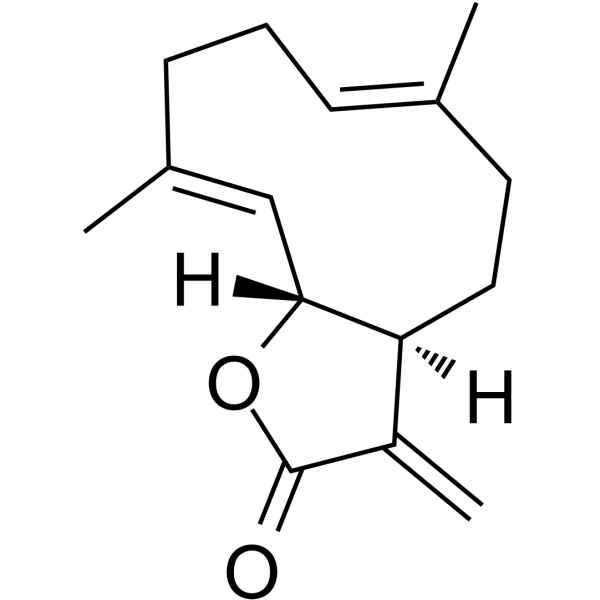上海金畔生物科技有限公司提供天然产物萜类及其苷类Terpenoids and Glycosides。
Costunolide (Synonyms: 木香烃内酯; (+)-Costunolide; Costus lactone) 纯度: 99.97%
Costunolide ((+)-Costunolide) 是一种天然的倍半萜内酯,它具有抗氧化、抗炎、抗过敏、骨重塑、神经保护、促进毛发生长、抗癌和抗糖尿病的特性。Costunolide 可诱导乳腺癌细胞周期阻滞和凋亡 (apoptosis)。

Costunolide Chemical Structure
CAS No. : 553-21-9
| 规格 | 价格 | 是否有货 | 数量 |
|---|---|---|---|
| Free Sample (0.1-0.5 mg) | Apply now | ||
| 10 mM * 1 mL in DMSO | ¥614 | In-stock | |
| 5 mg | ¥558 | In-stock | |
| 10 mg | ¥837 | In-stock | |
| 50 mg | 询价 | ||
| 100 mg | 询价 |
* Please select Quantity before adding items.
Costunolide 相关产品
•相关化合物库:
- Covalent Screening Library Plus
- Natural Product Library Plus
- Bioactive Compound Library Plus
- Apoptosis Compound Library
- Metabolism/Protease Compound Library
- Natural Product Library
- Anti-Cancer Compound Library
- Human Endogenous Metabolite Compound Library
- Covalent Screening Library
- Diabetes Related Compound Library
- Terpenoids Library
- Traditional Chinese Medicine Monomer Library
- FDA Approved & Pharmacopeial Drug Library
- Neuroprotective Compound Library
- Anti-Breast Cancer Compound Library
- Food-Sourced Compound Library
| 生物活性 |
Costunolide ((+)-Costunolide) is a naturally occurring sesquiterpene lactone, with antioxidative, anti-inflammatory, antiallergic, bone remodeling, neuroprotective, hair growth promoting, anticancer, and antidiabetic properties. Costunolide can induce cell cycle arrest and apoptosis on breast cancer cells[1][2][3]. |
||||||||||||||||||||||||||||||||
|---|---|---|---|---|---|---|---|---|---|---|---|---|---|---|---|---|---|---|---|---|---|---|---|---|---|---|---|---|---|---|---|---|---|
| IC50 & Target |
|
||||||||||||||||||||||||||||||||
| 体外研究 (In Vitro) |
Costunolide inhibits the colony formation, migrative and invasive abilities of the H1299 cells in a dose or time dependent manner[2]. Shanghai Jinpan Biotech Co Ltd has not independently confirmed the accuracy of these methods. They are for reference only. Cell Viability Assay[2]
Apoptosis Analysis[2]
RT-PCR[2]
Western Blot Analysis[2]
|
||||||||||||||||||||||||||||||||
| 体内研究 (In Vivo) |
Costunolide (20 mg/kg; i.p; daily; for 30 days) inhibits breast cancer through c-Myc/p53 and AKT/14-3-3 pathway[3]. Shanghai Jinpan Biotech Co Ltd has not independently confirmed the accuracy of these methods. They are for reference only.
|
||||||||||||||||||||||||||||||||
| 分子量 |
232.32 |
||||||||||||||||||||||||||||||||
| Formula |
C15H20O2 |
||||||||||||||||||||||||||||||||
| CAS 号 |
553-21-9 |
||||||||||||||||||||||||||||||||
| 中文名称 |
木香烃内酯;木烃香内酯 |
||||||||||||||||||||||||||||||||
| 运输条件 |
Room temperature in continental US; may vary elsewhere. |
||||||||||||||||||||||||||||||||
| 储存方式 |
-20°C, sealed storage, away from moisture and light *In solvent : -80°C, 6 months; -20°C, 1 month (sealed storage, away from moisture and light) |
||||||||||||||||||||||||||||||||
| 溶解性数据 |
In Vitro:
DMSO : ≥ 49 mg/mL (210.92 mM) * “≥” means soluble, but saturation unknown. 配制储备液
*
请根据产品在不同溶剂中的溶解度选择合适的溶剂配制储备液;一旦配成溶液,请分装保存,避免反复冻融造成的产品失效。 In Vivo:
请根据您的实验动物和给药方式选择适当的溶解方案。以下溶解方案都请先按照 In Vitro 方式配制澄清的储备液,再依次添加助溶剂: ——为保证实验结果的可靠性,澄清的储备液可以根据储存条件,适当保存;体内实验的工作液,建议您现用现配,当天使用; 以下溶剂前显示的百
|
||||||||||||||||||||||||||||||||
| 参考文献 |
|
